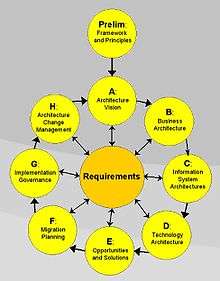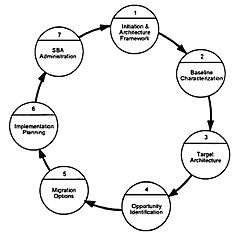The Open Group Architecture Framework

The Open Group Architecture Framework (TOGAF) is a framework for enterprise architecture that provides an approach for designing, planning, implementing, and governing an enterprise information technology architecture.[2] TOGAF is a high level approach to design. It is typically modeled at four levels: Business, Application, Data, and Technology. It relies heavily on modularization, standardization, and already existing, proven technologies and products.
TOGAF has been developed starting 1995 by The Open Group, based on DoD's TAFIM. As of 2016, The Open Group reports that TOGAF is employed by 80% of Global 50 companies and 60% of Fortune 500 companies.[3]
Overview
An architecture framework is a set of tools which can be used for developing a broad range of different architectures.[4] It should:
- describe a method for defining an information system in terms of a set of building blocks
- show how the building blocks fit together
- contain a set of tools
- provide a common vocabulary
- include a list of recommended standards
- include a list of compliant products that can be used to implement the building blocks
The ANSI/IEEE Standard 1471-2000 specification of architecture (of software-intensive systems) may be stated as: "the fundamental organization of a system, embodied in its components, their relationships to each other and the environment, and the principles governing its design and evolution."
However TOGAF has its own view, which may be specified as either a "formal description of a system, or a detailed plan of the system at component level to guide its implementation", or as "the structure of components, their interrelationships, and the principles and guidelines governing their design and evolution over time."
The Architecture Development Method (ADM) is core of TOGAF which describes a method for developing and managing the lifecycle of enterprise architecture.
TOGAF pillars
Enterprise architecture domains
TOGAF is based on four interrelated areas of specialization called architecture domains:
- Business architecture which defines the business strategy, governance, organization, and key business processes of the organization
- Applications architecture which provides a blueprint for the individual systems to be deployed, the interactions between the application systems, and their relationships to the core business processes of the organization with the frameworks for services to be exposed as business functions for integration
- Data architecture which describes the structure of an organization's logical and physical data assets and the associated data management resources
- Technical architecture, or technology architecture, which describes the hardware, software, and network infrastructure needed to support the deployment of core, mission-critical applications
Architecture Development Method
The Architecture Development Method (ADM) is applied to develop an enterprise architecture which will meet the business and information technology needs of an organization. It may be tailored to the organization's needs and is then employed to manage the execution of architecture planning activities.[5]
The process is iterative and cyclic. Each step checks with Requirements. Phase C involves some combination of both Data Architecture and Applications Architecture. Additional clarity can be added between steps B and C in order to provide a complete information architecture.
Performance engineering working practices are applied to the Requirements phase, and to the Business Architecture, Information System Architecture, and Technology architecture phases. Within Information System Architecture, it is applied to both the Data Architecture and Application Architecture.
Enterprise Continuum
The Enterprise Continuum is a way of classifying solutions and architectures on a continuum that ranges from generic foundation architectures through to tailored organization-specific both within and outside the Architecture Repository.[6] These include architectural models, architectural patterns, architecture descriptions, and other artifacts. These artifacts may exist within the enterprise and also in the IT industry at large.
The Enterprise Continuum consists of both the Architecture Continuum and the Solutions Continuum. The Architecture Continuum specifies the structuring of reusable architecture assets and includes rules, representations, and relationships of the information system(s) available to the enterprise. The Solutions Continuum describes the implementation of the Architecture Continuum by defining reusable solutions building blocks.
TOGAF culture
TOGAF Certified Tools
The Open Group has a certification program for TOGAF 9 Tools. For the latest register of certified tools see The Open Group register.[7]
Qualifications
The Open Group oversees formal qualifications in TOGAF at two levels, which can be taken following formal training or self-study.[8]
Foundation
(Level I) Ensures that an individual understands Enterprise Architecture along with core concepts and terminology of TOGAF.[8]
Certified
(Level II) Further to the Foundation qualification, this establishes that the candidate is able to analyse and apply their knowledge to business problems.[8]
Gaining TOGAF Certified status automatically confers free membership of the Association of Enterprise Architects.[9]
History
TOGAF was initiated in the early 1990s as methodology for the development of technical architecture, and has been developed by The Open Group into an extensive enterprise architecture framework.[11] In 1995, the first version of TOGAF (TOGAF 1.0) was presented. This version was mainly based on the Technical Architecture Framework for Information Management (TAFIM), developed since the late 1980s by the US Department of Defense
In December 2001 TOGAF 7, the "Technical Edition", was published.[12] TOGAF 8 ("Enterprise Edition") was first published in December 2002 and republished in updated form as TOGAF 8.1 in December 2003. Around 2005 TOGAFTM became a registered trademark of The Open Group.[13] In November 2006 the Open Group released TOGAF 8.1.1. According to The Open Group, as of February 2011, over 15,000 individuals are TOGAF Certified.[14] As of September 2012 the official register has over 20,000 certified individuals.
The latest version is TOGAF 9.1, launched on 1 December 2011. An evolutionary development from TOGAF 8, TOGAF 9[15] includes many new features including:
- Increased rigor, including a formal Content Metamodel that links the artifacts of TOGAF together (although there are some problems with the Metamodel)[16]
- Elimination of unnecessary differences
- Many more examples and templates
Additional guidelines and techniques include:
- A formal business-driven approach to architecture
- Business capability-based planning
- Guidance on how to use TOGAF to develop a Security Architecture or SOA
The Open Group provides TOGAF free of charge to organizations for their own internal noncommercial purposes.[17]
Criticism
Despite TOGAF being considered as the de facto standard in an EA practice, it is not without its critics:
- Research evidence shows that "most TOGAF recommendations are usually found inapplicable" and not followed even in the organizations included in the list of TOGAF-users provided by The Open Group.[18] That is why TOGAF can be considered only as "a toolkit of random EA-related recommendations" and "‘using TOGAF’ can be best explained as ‘studying TOGAF and then doing something else instead’"[19]
- Real examples demonstrating the actual practical usage of TOGAF's recommendations are missing. "There is a pressing need for some detailed worked examples and use cases. Although these were requested, they were not forthcoming from TOGAF trainers or The Open Group"[20]
- EA practitioners report that TOGAF can hardly be followed step-by-step. "Our initial assumptions about TOGAF were that it would be a sort of 'methodology' that we could follow to produce our EA, however this turned out not to be the case"[20]
- TOGAF's prescriptions are vague and inarticulate since it "only states that the ADM should be adapted without specifying how"[21]
- Jason Bloomberg argues that "for many organizations, TOGAF has gained traction simply because it’s better than doing nothing"[22]
References
- ↑ Stephen Marley (2003). "Architectural Framework," at aiwg.gsfc.nasa.gov, NASA /SCI. Retrieved 10 Dec 2008 (webarchive.org).
- ↑ Dirk Draheim, Gerald Weber eds. (2007) Trends in Enterprise Application Architecture: 2nd International Conference, TEAA 2006, Berlin, Germany, November 29 - December 1, 2006, Revised Selected Papers. p. 260
- ↑ TOGAF Worldwide
- ↑ TOGAF Introduction The Open Group Architecture Framework. Accessed 22 Jan 2009.
- ↑ The process flow can be seen as an image located here: Architecture Development Cycle
- ↑ "Enterprise Continuum". The Open Group. Retrieved 4 January 2014.
- ↑ The Open Group Tool Certification Register
- 1 2 3 "TOGAF 9 Certification". The Open Group. Retrieved 11 January 2014.
- ↑ "TOGAF Certification FAQ". The Open Group. Retrieved 11 January 2014.
- ↑ Department of Defense (1996). Technical Architecture Framework for Information Management. Vol. 4. April 1996
- ↑ Marc Lankhorst (2013) Enterprise Architecture at Work: Modelling, Communication and Analysis p. 23
- ↑ Jaap Schekkerman (2003) How to Survive in the Jungle of Enterprise Architecture. p. 119
- ↑ Tom van Sante, Hans Van Den Bent (2007) Togaf the Open Group Architectural Framework: A Management Guide. p. iv
- ↑ 15,000 certifications
- ↑ TOGAF 9.1 White Paper An Introduction to TOGAF Version 9.1 http://www.opengroup.org/togaf/
- ↑ Gerber A; Van der Merwe, A; Kotze, P: 2010. Towards the Formalisation of the TOGAF Content Metamodel using Ontologies. To appear in: Proceedings of The 12th International Conference on Enterprise Information Systems (ICEIS 2010). INSTICC
- ↑ The Open Group (2011). TOGAF® Version 9 - Download. Architecture Forum. Retrieved on 2011-11-17 from http://www.opengroup.org/architecture/togaf9/downloads.htm.
- ↑ "Enterprise architecture is not TOGAF", Kotusev, S., January 2016
- ↑ "The critical scrutiny of TOGAF", Kotusev, S., April 2016
- 1 2 Anderson, P., Backhouse, G., Townsend, J., Hedges, M. and Hobson, P. (2009). Doing Enterprise Architecture: Enabling the Agile Institution. Bristol, United Kingdom: Joint Information Systems Committee (JISC).
- ↑ Winter, K., Buckl, S., Matthes, F. and Schweda, C. M. (2010). Investigating the State-of-the-Art in Enterprise Architecture Management Methods in Literature and Practice. In: Sansonetti, A., ed. Proceedings of the 4th Mediterranean Conference on Information Systems, Tel Aviv, Israel.
- ↑ "Enterprise Architecture: Don't Be a Fool with a Tool", Jason Bloomberg, visited 19 May 2016
External links
| Wikimedia Commons has media related to TOGAF. |
- Official website
- TOGAF 9.1 Online
- TOGAF 8.1.1 Online
- Developer.com: TOGAF: Establishing Itself As the Definitive Method for Building Enterprise Architectures in the Commercial World (June 2004)
- TOGAF or not TOGAF: Extending Enterprise Architecture beyond RUP (January 2007)
- Practical advice: How to bring TOGAF to life (October 2007)
